투약 방법, How to administrate the medicines
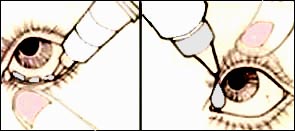
사진 78. 눈에 액체형태 안약이나 안연고를 넣을 때.
Copyright ⓒ 2011 John Sangwon Lee, MD., FAAP
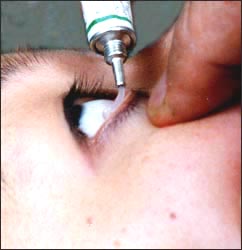
사진 79. 눈에 안연고를 넣을 때.
Copyright ⓒ 2011 John Sangwon Lee, MD., FAAP
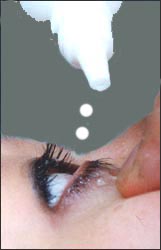
사진 80. 눈에 안약 방울(안약 점적제)을 넣을 때.
Copyright ⓒ 2011 John Sangwon Lee, MD., FAAP
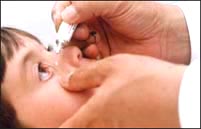
사진 77. 눈에 안연고를 넣을 때.
Copyright ⓒ 2011 John Sangwon Lee, MD, FAAP

사진 81. 항문 속에 좌약을 넣을 때.
Copyright ⓒ 2011 John Sangwon Lee, MD., FAAP
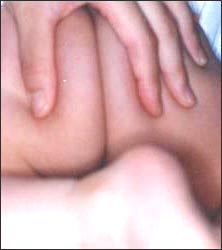
사진 82. 좌약을 항문에 넣은 후 잠시 동안 항문을 꼭 오므린다.
Copyright ⓒ 2011 John Sangwon Lee, MD., FAAP
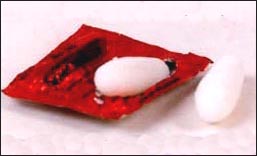
사진 83. 좌약
Copyright ⓒ 2011 John Sangwon Lee, MD., FAAP
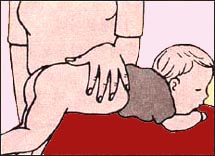
사진 84. 좌약을 항문에 넣어 치료할 수 있다.
Copyright ⓒ 2011 John Sangwon Lee, MD., FAAP
- 각 종의 약물의 형태에 따라, 약물의 종류에 따라, 병의 종류에 따라 약물을 쓰는 방법이 다르다.
소아청소년(0~18세)들에게 약물을 처방 원칙
- “좋은 약은 입에 쓰다.”라는 속담이 있다. 이제 그 말은 옛말이 되었다.
- 요즘도 쓴 약이 있지만 대부분의 약은 꿀이나 설탕과 같이 달고 보기도 좋고 먹기도 쉽게 만들어 판다.
- 점적약제(적제약/방울약),
- 시럽약(시럽제),
- 엘릭서약(엘릭시르제),
- 현탁액약(현탄액제),
- 알약(정제),
- 캡슐 약,
- 좌약,
- 주사약,
- 가루약,
- 분무제,
- 연고,
- 크림,
- 부착제 등 여러 형태의 약물이 있다.
- 요즘 대부분의 제약 회사가 약물을 제조할 때 환아의 나이와 체중에 적합하게 약물의 용량을 미리 계산해서 나이나 체중에 따른 용량으로 조제 한다.
- 그래서 환아가 약물을 쉽게 먹일 수 있게 되었다.
- 몹시 쓰기 때문에 먹기 어려운 약물은 캡슐 속에 넣어 캡슐 약물로 만들고, 쓴 가루 약물을 조그마한 알약으로 만들어 그 알약 표면에 설탕 등 당질을 입혀 먹기 좋게 만든다.
- 또한 알약을 쉽게 넘길 수 있도록 알약의 크기를 아주 작게 만들기도 한다.
- 알약이나 캡슐 약을 삼킬 수 없는 어린이들을 위해 가루약에 설탕이나 다른 종류의 당질을 가미하고 가루약에 물을 타서 만든 시럽약, 알코올을 극소량의 가하고 당질을 넣어 만든 엘릭서약, 가루약에다 당질을 이미 혼합하여 약을 먹을 때마다 물에 타서 먹게 만든 달콤한 가루약, 가루약과 당질을 섞은 후 물을 타서 만든 현탁액 약(현탁 액제) 등이 있다.
- 또 어떤 병을 앓으면서 그 병으로 인해 구토할 때, 약을 먹고 그 약으로 인해 구토할 때, 약을 먹으려고 하지 않거나 약을 도저히 경구로 먹일 수 없을 때는 항문 속에 넣을 수 있는 좌약이나 관장약이 있다.
- 경구를 통해, 피부를 통해, 비강 속으로, 기도 속으로 투여하는 대신 항문을 통해 투약할 수 있는 좌약, 관장, 주사로 투여할 수 있는 주사약 등이 있다.
- 이렇게 약의 종류와 형태가 다양하다.
- 그 중 약의 효과가 가장 빠르게 나타나고, 부작용이 가장 적고, 경구로 섭취하기나 쓰기가 가장 쉬우며, 가격이 가장 싼 약물을 골라 쓰는 것이 이상적이다.
- 어떠한 종류의 약물, 어떠한 형태의 약물을 골라서 쓸 것인지는 그 환아의 나이와 그 환아가 그런 약을 경구로 먹을 수 있는지의 여부, 병세의 중증도, 병의 종류, 경제, 약의 종류 등에 따라 의사와 부모 그리고 어떤 때는 환아와 함께 상의해서 결정할 때가 많다.
- 의사가 약을 매 여섯(6) 시간마다 쓰라고 처방을 했었을 때는 될 수 있는 한 매 여섯 시간간격을 두고 그 약을 써야 한다.
- 하루에 한 번만 쓰라고 처방했으면 하루 중 어느 때든지 한 번(1회) 쓰면 된다. 그러나 될 수 있는 한 24시간 간격을 두고 한 번 쓰는 것이 좋다.
- 하루에 두 번(2) 쓰라고 하면 가능한 한 매 12시간 간격을 두고 한 번씩 쓰면 된다.
- 하루에 세 번(3) 쓰라고 하면 매 여덟(8) 시간 간격을 두고 쓰면 된다.
- 하루에 네 번(4) 쓰라고 하면 가능한 한 매 여섯(6) 시간 간격을 두고 1회 쓰든지, 또는 하루 중 첫 번째는 아침 6~7시경, 두 번째는 오후 1~2시경, 세 번째는 오후 5~6시경, 네 번째는 잠자기 바로 전에 써서 하루 총 네(4) 번 쓰면 된다.
- 공복에 약을 먹으라고 하면 식사를 한 후 2~4시간 될 때 쓰면 된다.
- 그렇지만 신생아들이나 영아들, 또는 유아들은 시간을 정해 놓지 않고 음식물을 수시로 아무 때나 자주 먹는 경향이 있고, 어떤 아이는 때 없이 주식과 간식을 가리지 않고 음식물을 자주 먹기 때문에 가능한 한 공복 시를 찾아서 처방한 약을 쓰면 된다.
- 약은 별다른 이유가 없는 한 의사가 처방한 복용 기간 동안 다 써야 한다.
- 어떤 병을 앓을 때 대부분의 환아들은 식욕이 없어 음식물을 잘 먹지 않는다.
- 그래서 앓는 아이들의 대부분은 음식물도 먹기 싫어하고, 약도 먹기 싫어하고, 또 약도 음식물도 먹지 않으려 하는 때가 많다.
- 말을 잘 알아듣고 이해할 수 있는 아이에게 약을 주어야 할 때는 약을 주기 전에 약을 먹어야 하는 이유를 간단히 설명해야 한다.
- 예를 들면, 다섯 살 먹은 유아가 감기에 걸려서 열이 나기 때문에 타이레놀로 해열시킬 때 왜 타이레놀로 치료 하는지, 그 이유를 간단하게 설명해야 한다.
- “너에게 열이 나고 네가 아프고 타이레놀을 먹으면 그 열이 떨어질 것이고 목구멍과 머리가 덜 아플 것이다.” 또는 “이 약은 좀 쓰지만 먹으면 머리 아픈 것이 빨리 나을 수 있기 때문에 꼭 먹어야 한다.”라는 식으로 설명해 준 후 약을 주어야 한다.
- 약이 상당히 쓴데도 “쓰지 않다”고 거짓말을 하면서 어린이에게 약물을 먹인다든지, 주사를 맞을 때 아플 것을 뻔히 알면서도 “아프지 않다”고 속인 후 주사를 놔 주어서는 절대로 안 된다.
- 아주 쓴 약을 “꿀같이 단 약이다”라고 속인다든지, 약을 “과자나 사탕”이라고 속여서 먹여도 안 된다.
- 음식물과 함께 먹으면 약의 효력이 다 없어질 수 있는 약물을 음식물과 함께 먹여서도 안 된다.
- 음식물과 함께 먹여야 하는 약물은 음식물과 함께 먹여야 한다.
- 약은 음식물과 꼭 함께 먹을 필요는 없지만 음식물과 함께 먹어도 괜찮은 약물은 음식물과 함께 먹을 수 있고, 약을 먹은 후 바로 평소 좋아하는 과자나 주스 등을 먹을 수 있다.
- 약물을 먹은 후, 잊지 말고 “잘 먹었다”라고 칭찬해 주고 “감사하다”는 말을 한다.
- 약을 안 먹이려고 온갖 수단을 다 쓰는 아이도 가끔 있다. 또 온갖 방법으로 먹일 수 없는 때도 가끔 있다.
- 이런 경우, 의사에게 문의하여 그 아이가 먹기 쉬운 다른 종류의 경구용 약이나 주사용 약, 또는 좌약 등으로 대체할 수 있는지 알아야 한다.
- 모든 방법을 다 써도 아이가 액체 형태의 약물을 먹으려고 하지 않을 때 아이의 코를 꼭 붙들고 입을 벌린 후 액체 형태의 약물을 입 안 속에 한두 방울씩 떨어 트려 그 약을 삼키도록 할 수 있다.
- 이런 식으로 약을 먹일 때는 한 티스푼 1희 분량의 약을 한꺼번에 한 입에 다 넣고 먹이려면 사레들릴 수 있다.
- 한 방울씩 입 안에 떨어뜨려 주면 대게의 경우, 그 아이는 할 수 없이 다 받아 삼키는 것이 보통이다. 이 때 혓바닥 밑에다 떨어트려 넣든지 입 안에 넣는다.
- 액체 형태의 물약은 스푼으로 먹이는 대신 약물 투여용 스포이드나 약물 투여용 주사기로 약을 먹일 수 있다.
- 그렇지만 알약을 삼킬 수 없는 아이에게 알약을 강제로 입 안에 넣고 삼키도록 강요해서는 안 된다.
- 아이가 약을 먹은 후 바로 토할 때는 먹은 약의 부작용으로 토하는지, 그 당시 앓고 있는 병으로 인해 토하는지, 그 외의 다른 이유로 토하는지 알아야 한다. 따라서 약을 먹고 구토하면 일단 의사에게 문의해야 한다.
- 약물로 치료할 때 약을 먹고 나서 먹은 약을 토하면 약의 효과를 제대로 얻을 수 없다.
- 따라서 어떤 병을 치료하기 위해 쓴 약을 먹고 토하면 주사용 약이나 좌약 등으로 대체 치료를 할 때도 있고, 병원에 입원시켜 주사약 치료를 받아야 할 때도 있다.
- 특히 생명에 위험한 뇌막염이나 패혈증, 또는 골수염 등으로 심하게 앓는 아이는 무엇을 먹든지 안 먹든지 잘 구토할 수 있고 치료 약물의 성분이 치료 표적 병소에 즉시 도달해서 치료효과를 최대한으로 즉시 얻어야 한다.
- 때문에 위독한 병을 앓을 때는 병원 입원해서 가능한 한 주사약으로 치료해야 한다.
액체 형태 약을 투약할 때 약의 용량을 측정하는 의료 기구와 용량
①티스푼(Teaspoon)은 5cc
②테이블스푼(큰 숟가락/Tablespoon)은 15cc
③투약용 컵(Medication cup): 컵에 눈금이 있고 각 눈금에 따라 용량이 정해져 있음.
④기존 눈금이 있는 투약용 스푼이나 드로퍼(Calibrated spoon or dropper)
⑤기존 눈금이 있는 투약용 주사기(Calibrated syringe)
⑥투약용 우유병과 젖꼭지(Medibottle) 등이 있다.
다음은 “약물 투여 의술과 인술, 약을 잘 못 먹이겠어요 ”에 관한 인터넷 소아청소년 건강상담 질의응답의 예 입니다.
Q&A.약물 투여 의술과 인술, 약을 잘 못 먹이겠어요
Q.
- 전.. 19개월 접어드는 우리 애기 땜에 넘넘 속이 상해서 이렇게 글을 적어 올립니다.
- 다름이 아니라 약을 억지로 먹이면 바로 토해 버리고 심지어 아침에 먹은 것까지 다 토해 버립니다.
- 아플 때 마다 곤욕이고 약을 안 먹으니 빨리 안 낫고..
- 어떻게 해야 하나요? 약을 잘….
- 먹일 수 있는 방법이 없나요?
- 주사기…숟가락 모든 방법을 동원했지만…
- 제발 도와주세요…
- 어떻게 해야 약을 잘 먹일 수가 있는지…
- 도와주세요..제발 지금도 애가 많이 아픈데 약을 먹지 않아서..넘넘..속상해요…
- 답변 부탁드립니다…
A.
- 장군님께
- 안녕하세요. 좋은 질문해 주셔서 감사합니다.
- 자녀의 나이, 성별, 과거 병력, 가족 병력, 진찰소견, 임상검사 등의 정보를 많이 알수록 답변을 드리는데 도움이 됩니다. 주신 정보를 토대로 해서 답변 드리겠습니다.
- 우리 소아청소년과 의사들이 이런 문제들을 매일 겪고 있습니다.
- 자녀에게 약을 먹일 때마다 “투약전쟁”을 하고 있는 부모들이 많습니다.
- 아기뿐만 아니라 거의 모든 다른 아이들에게도 또 부모들에게도 거의 같게 생기는 문제입니다.
- 의사가 처방한 약을 5일 간 또는 10일 간 계속 먹을 때 약 먹이기가 얼마나 어려운지 저도 경험했습니다.
- 소아청소년(0~18세)들에게 약물을 처방할 때 의사와 부모들은 다음과 같은 경우에 대비해서 약물을 선택하는 것이 보통입니다.
- 그 환아의 나이에 따라 투약하기에 가장 쉬운 약물을 선택해야 합니다.
- 효과가 가장 좋은 약물을 선택해야 합니다.
- 그 다음, 부작용이 가장 적은 약물을 선택해야 합니다.
- 그뿐만 아니라 약값이 가장 저렴한 약물을 선택합니다.
- 부모가 자녀에게 생긴 병을 간호할 수 있는 능력 등을 고려해서 약물을 선택합니다.
- 부모와 상담해서 환아에게 가장 적절한 종류의 약물을 선택하고 그 종류의 약물들 중에서 가장 적절한 형태의 약물을 선택합니다.
- 즉 가능 하면 부모와 환아와 의사가 그 당시 상황에서 가장 적절한 약물의 종류와 형태를 결정하는 것이 이상적입니다.
- 그러나 이렇게 할 수 없을 때는 의사가 환아에게 가장 좋은 약물을 선택해서 처방할 때도 많습니다.
- 이런 이유로도 부모는 적어도 반의사가 되어야 합니다.
- 경구용, 주사용, 경구 흡인용, 분무용, 비강 분무용, 피부 도포용, 피부 부착용, 좌약 등 여러 형태의 약물들 중 한 가지의 형태의 약물을 선택합니다.
- 이때도 가능한 한 부모와 환아와 의사가 그 아이의 병을 치료하는 데 가장 좋은 약물과 그 약물의 형태를 결정하는 것이 좋습니다.
- 경구용 알약, 가루약, 물약, 드롭(점적약제) 등 여러 가지 형태의 약물들 중 가장 적절한 형태의 약물을 선택합니다.
- 주사약으로 꼭 치료해야 할 때는 혈관주사, 근육주사 또는 피하주사 중 어떤 종류의 주사 방법으로 치료할 것인가를 결정합니다.
- 치료의 효과가 같은 종류가 다양한 형태의 약물들 중 주사나 경구 투여용 약물이 있을 때는 가능한 한 경구 투여용 약물을 선택합니다.
- 여러 번 먹어야 치료 효과가 날 약물과 한번 먹어도 치료 효과가 날 수 있는 2 종류의 약물이 있을 때는 가능한 한 한번 먹는 약물을 선택합니다.
- 최소한도의 치료 횟수로 최대한의 치료효과를 얻을 수 있는 약물을 선택하는 것이 보통입니다.
- 치료하는 병의 종류, 그 병의 중증도 등에 따라 의사나 간호사가 병원에서 약물을 경구로 또는 주사로 직접 투여해야 할 때도 있습니다.
- 의사가 처방한 약물을 처방한 대로 투약하지 않아서 병이 낫지 않고 악화될 위험성이 있을 때, 부모도 최대한도로 의사가 처방한 대로 투약하려고 노력하지만 환아가 약물을 안 먹을 때, 부모가 의사의 지시에 따라 도저히 약물을 먹일 수 없는 때는 경구 투여용 약물로 치료하는 대신 주사용 약물로 치료해야 할 때도 있습니다.
- 경구용으로 제조된 약도 없고 주사용 약으로만 제조된 경우에는 물론 주사로만 치료합니다. 이런 경우, 일반적으로 입원해 치료합니다.
- 뇌막염, 패혈증 등 생명을 위협하는 위중한 병을 항생제 주사로 치료할 때는 항생제 등 약물이 표적 병소에 속히 적절히 들어가 약물의 효과를 빨리 보게 주사용 항생제로 치료하는 것이 보통입니다.
- 어떤 병을 앓을 때 구토를 할 수 있고 설사를 할 수 있습니다. 그런 소아 환아에게 경구로 약물을 투여하면 그 약물을 토하거나 설사를 통해서 약물이 설사 변과 같이 배설되어 약물 치료효과가 나타날 수 없습니다.
- 이런 점을 고려해서 위중한 병을 앓는 환아들을 경구용 약물로 치료하는 대신에 주사용 약물로 치료하고 또 때로는 병원에 입원해서 혈관 주사약으로 치료 합니다.
- 의사나 간호사의 치료 지시에 따르지도 않고 그 치료방법을 이해하지도 못하고 처방한 약으로 적절히 치료를 해 줄 수 없는 부모들도 있습니다. 이런 경우는 그 자녀들의 병을 가장 적절히 치료하기 위해서는 집에서 치료하는 것보다 병원에 입원해서 치료하기도 합니다.
- 이와 같이 어떤 병을 어떤 종류의 약물로 치료할 때 그 당시, 그 상황에서 여러 가지 조건에 적절한 약물을 선택하고 그 약물을 쓰는 방법에 대해서 신경을 많이 써야 할 때가 의사에게도 생기고 부모들에게 생깁니다.
- 이렇게 약물을 쓸 때 약물을 복용하는 방법에 대해서 일률적으로 말씀드리기 곤란합니다.
- 아이들에게 경구로 먹이는 약물의 종류에 따라 그 약물에다 설탕을 가미한 후 그 약물을 먹일 수 있고 물로 더 희석해 덜 쓰게 해서 먹이는 방법도 있고, 심지어는 주스 병에 타서 먹일 수도 있고, 막대사탕(Lolloypop) 등 사탕에 약물을 발라 빨아먹게 할 수 있고, 때로는 강제로 약물을 먹일 수 있습니다.
- 그러나 의사가 처방한 것과 달리 약물을 먹이기 전에 의사에게 꼭 문의한 후 그렇게 다른 방법으로 약물을 투여해도 된다고 할 때만 달리 투여해도 됩니다.
- 경구용 약물을 강제로 먹이면 거의 대부분의 아이들은 토하기로 합니다.
- 주의할 것은 약물을 먹은 후 먹은 약물의 부작용으로 위장염 등이 생겨 토할 수 있고 약물 알레르기로 토할 수 있습니다.
- 토할 때는 약물을 계속 먹여서는 안 됩니다.
- 주사기와 비슷한 주사기형 투약기로 약물을 먹일 수 있습니다. 어떤 아이들은 주사기형 투약 기구를 주사기로 오해할 수 있고, 주사를 자기에게 놓아 주는 줄 알고 놀래기도 합니다.
- 이와 같이 약물 먹이는 것은 간단하지 않습니다.
- 즉 약물 투여 의술과 인술이 여기에도 적용됩니다.
- 소아청소년과에서 이 문제에 관해 상담하시기 바랍니다.
- 약물과 약물의 형태,
- 투약 방법 등을 참조하시기 바랍니다.
- 소아청소년과에서 진찰 진단 치료를 받고 상담하시기 바랍니다. 질문이 더 있으시면 다시 연락 주세요. 감사합니다. 이상원 드림
다음은 “안약 넣는 방법 ”에 관한 인터넷 소아청소년 건강상담 질의응답의 예 입니다.
Q&A. 안약 넣는 방법
Q.
- 9개월 된 아기가 눈병이 났어요.
- 이 사이트에서 찾아보니 증상이 박테리아성 결막염 같아요.
- 클리닉에 있는 의사를 찾아갔었는데 처방으로 준 안연고를 성인에게 넣는 양만큼 넣어주라고 했어요.
- 혹시나 싶어 넣으라는 용량의 반만 넣었거든요. 그래도 되는 건지 아님 어른용량만큼 다 넣어야 하는 건지 궁금해요.
A.
안녕하세요.
좋은 질문해 주셔 감사합니다.
자녀의 나이 성별, 과거병력, 진찰소견, 임상검사 등 자세한 정보가 더 있으면 보다 더 좋은 답변을 드릴 수 있습니다. 그러나 주신 정보를 토대로 답변을 드리겠습니다.
약을 쓸 때 약의 용량을 치료용량 이상으로 더 많이 쓰면 약으로 인해서 부작용이 생길 수 있고 심지어는 생명에 위험할 수 있습니다.
권장하는 치료약의 용량보다 훨씬 적은 치료약의 용량을 쓰면 물을 마시는 것과 같이 아무런 치료효과가 없을 수 있습니다.
약을 쓸 때는 의사가 처방한 치료 용량을 써야 합니다.
아마도 적절한 치료용량을 처방해 주셨을 줄 믿습니다.
만일 치료약의 용량 이상으로 더 많은 약 용량을 처방해 준 것 같으면 그 약을 조제한 약사나 그 약을 처방해 준 의사에게 직접 문의하시기 바랍니다.
일반적으로 눈에 넣는 항생제 안연고나 점적약제를 눈에 넣으면 어린 아이들은 울거나 그 약으로 인해 눈이 자극받아 눈물이 나고 그 눈물로 인해서 눈에 넣는 안약이 쉽게 씻겨 질 수 있습니다.
그런 이유로 항생제 안연고나 눈 점적약제의 소아 치료 용량은 성인들에게 쓰는 항생제 안연고나 항생제 안점적제 용량과 거의 같은 용량을 넣는 경우도 있습니다.
질문이 더 있으시면 다시 연락 주시기 바랍니다. 감사합니다. 이상원 드림
다음은 “중이염과 삼출성 중이염 ”에 관한 인터넷 소아청소년 건강상담 질의응답의 예 입니다.
Q&A. 중이염과 삼출성 중이염
Q.
- 저의 아이는 15개월이 되었어요. 밥도 잘먹고 비교적 건강한 여자아이입니다.
- 지난달 4월30일경 밤에 보체어 병원 응급실을 갔더니 중이염 (오른쪽)이라하여 외래 이비인후과에서 진료보고 약을 하루먹자 설사를 하여 집가까운 이비인후과에 갔습니다
- 거기서 세파쿨러라는 항생제 치료를 그때부터 2주정도 했는데 의사말 조금씩 밖에 나아지질 않는다며 옴니세프로 항생제를 교체하고 하루 먹이니 아이가 빨간 설사를 하였어요. 그러자 3일간 중지하였고 록시그란 이란 항생제로 바꾸어 주었어요 항생제 를 잠시 중지했던 3일간 사이에 감기가 걸려 후두염까지 되어 아이가 무척 힘들어하여 분당00병원 응급실로가 치료를 하고 다음날 부터 소아과를 다니면서 오구멘틴 을 또 2주 정도 썼어요
- 이후 또 세프템 건조시럽을 또 일주일 썼어요
- 그래도 중이염이 나아지질 않았다고 소아과에서는 바난건조시럽을 일주일 처방을 내주었어요
- 저는 이제 약을 먹이기가 정말로 아이도 약을 먹이고 나면 얼굴이 하얗게 되면서 힘들어해요
- 같은 병원 이비인후과 진료를 해 보았어요(소아과에서 청력 검사를 해 보라 하여). 이비인후과 의사는 항생제를 먹을 만큼 너무 많이 먹었으니 중지 해보자 합니다 그러나 귀의 중이염은 아직 있다고 합니다
- 저는 약을 계속 먹이자니 내성 같은 문제도 걱정이고 안 먹이자니 중이염이 심해질까 걱정이고 정말 어느 과 선생님 말을 들어야 할지 고민입니다
- 아이는 지금은 잘 먹고 감기증상도 없어요
- 약을 안 먹이고 있으면 어떻게 되나요? 또 점 점 강한 항생제를 많이 먹이면 이로 인해 우리아이가 또 다른 문제가 생기지 않을까요 ?
- 어떻게 해야 우리아이에게 가장 좋은 방법인지 정말 갈등입니다 선생님 아이라 생각하시고 좋은 방안을 가르쳐 주세요
A.
- 현숙님
- 안녕하십니까. 좋은 질문해 주셔서 감사합니다.
- 자녀의 나이와 성별, 과거 현재 가족의 병력, 증상 증후와 진찰소견, 적절한 임상검사 등의 결과를 종합해서 진단 치료하는 것이 이상적이지만 주신 정보를 참작해서 답변을 드립니다.
- 환자를 치료할 때는 항시 내 몸을 치료하는 것 같이 또는 내 자식의 병을 치료하는 것 같이 사랑으로 치료하지요.
- 자식이 빵을 달라고 할 때 돌을 주지 않고 생선을 달라고 할 때 독사를 주지 않습니다. 상당히 혼동되시겠습니다. 아시겠지만 우리 소아과 의사들은 거의 매일 빼놓지 않고 보는 병이 소아 중이염입니다.
- 소아 중이염의 원인 증상 징후+ 진단 치료는 [부모도 반의사가 되어야 한다–소아가정간호백과]-제 18권 소아청소년 이비인후 질환–중이염, 재발성 중이염, 만성 중이염, 삼출성 중이염 등을 참조하시기를 바랍니다.
- 박테리아성 급성 중이염은 경구용 아목사실린(Amoxillin)으로 약 10일 동안 치료한 다음 다시 추적 진찰을 받고 완치가 되지 않으면 오그멘틴(Amoxicillin-clavulante/Augmentin) 등으로 다시 약 10일간 치료하는 것이 일반적인 치료 방법입니다.
- 그러나 사는 나라에 따라 지역에 따라, 그동안 중이염을 치료했을 때 치료의 효과 등에 따라 1차 급성 중이염 치료 선택 항생제의 종류는 다를 수 있습니다.
- 페니실린에 알레르기가 있는 환아들의 중이염을 세파크롤(Cefaclor), Cefuroxime, 또는 다른 항생제들 중 한 종류의 항생제를 선택해서 치료합니다. 이런 식으로 소아 박테리아성 급성 중이염을 치료하면 잘 낫습니다.
- 드물게는 급성 중이염을 치료한 후 무균성 삼출성 중이염이 생길 수 있습니다. 이때의 치료 방법이 다소 복잡해집니다.
- 무균성 삼출성 중이염의 정도에 따라 2~8주 동안 약물로 치료하지 않고 관찰적 치료만 할 수도 있고 그 동안 한두 번 정도 추적 진찰을 해 잘 나아가는지 낫지 않고 더 심해지는지 알아보기도 합니다. 대부분의 무균성 삼출성 중이염은 자연히 낫습니다.
- 때로는 무균성 삼출성 중이염이 완전히 낫지 않고 청력이 감소될 수 있습니다. 이때는 이비인후과는 고막에 통기관을 꼽는 수술 치료도 합니다. 그 고막 통기관 삽입 수술 치료를 하는 시기는 그때그때에 따라 다릅니다.
- 아마도 지금 여아의 중이염은 무균성 삼출성 중이염 상태에 있다고 생각됩니다.
- 따라서 항생제로 치료하지 말고 관찰적 치료만 하시고 2~3주 후에 그 무균성 삼출액이 중이강 속에서 다 없어졌는지 확인하는 정도의 치료를 하면 된다고 생각됩니다.
- 관찰적 치료는 좋은 치료 방법 중 하나입니다.
- 연구에 의하면 급성 중이염을 항생제로 적절히 치료한 이후 30일이 지난 후에 그 중이염 환자들의 30% 정도는 중이강 내 무균성 삼출액이 그냥 남아 있을 수 있고, 또 90일이 지난 이후에도 그 중이염 환자들의 10% 정도는 그 중이강 내에 약 10% 정도 무균성 삼출액이 남아 있을 수 있다고 합니다.
- 급성 중이염을 적절히 치료한 후에도 중이 내에 무균성 삼출성 액이 오랫동안(90일) 남아 있을 수 있다는 연구입니다. 이런 경우 대부분은 알레르기성 비염이나 천식 등의 알레르기성 질환을 함께 앓고 있습니다.
- 무균성 삼출성 중이염을 가진 아이들의 아데노이드가 커져 있을 수 있습니다. 그래서 알레르기성 비염을 동시 치료하는 경우도 많습니다. 오늘은 이 정도로 말씀드리겠습니다.
- 제가 드린 말씀은 주신 정보를 토대로 해서 말씀드린 것을 이해해 주시고 단골의사 선생님의 계속적인 치료를 받으시기 바랍니다. 질문이 더 있으면 또 방문하세요. 감사합니다. 이상원 드림
How to administer the medicines
Picture 78. When liquid eye drops or ointment are placed in the eye. Copyright ⓒ 2011 John Sangwon Lee, MD., FAAP
Photo 79. When putting eye ointment in the eyes. Copyright ⓒ 2011 John Sangwon Lee, MD., FAAP
Photo 80. When putting drops of eye drops (eye drops) into the eyes. Copyright ⓒ 2011 John Sangwon Lee, MD., FAAP
Photo 77. When putting eye ointment in the eyes. Copyright ⓒ 2011 John Sangwon Lee, MD, FAAP Photo 81. When inserting a suppository into the anus. Copyright ⓒ 2011 John Sangwon Lee, MD., FAAP
Picture 82. After inserting the suppository into the anus, close the anus for a while. Copyright ⓒ 2011 John Sangwon Lee, MD., FAAP
Photo 83. Suppositories Copyright ⓒ 2011 John Sangwon Lee, MD., FAAP
Picture 84. Suppositories can be placed in the anus for treatment. Copyright ⓒ 2011 John Sangwon Lee, MD., FAAP
• Depending on the type of drug, the type of drug, and the type of disease, the method of using the drug is different. Principles of prescribing drugs to children and adolescents (0-18 years old)
• There is a saying, “Good medicine is bitter in the mouth.” Now that word has become a thing of the past.
• Even today, there are bitter medicines, but most medicines are sweet, like honey or sugar, and they look good and are easy to eat.
• Drops (drops/drops),
• Syrup medicine (syrup);
• Elixir Pledge (Elixirje),
• Suspension drugs (suspension solutions);
• pills (tablets);
• capsule medicine;
• suppositories;
• Injections;
• Powdered medicine;
• aerosols;
• Ointment,
• cream,
• There are several types of drugs such as adhesives.
• When most pharmaceutical companies manufacture drugs these days, they pre-calculate the dosage appropriate for the age and weight of the child and prepare the dosage according to the age or weight of the child.
• So the child can easily give the drug.
• Drugs that are difficult to eat because they are too bitter are put into capsules and made into capsules, and bitter powdered drugs are made into small tablets and sugar or other sugar is coated on the surface of the tablets to make them easier to eat.
• We also make the size of the pills very small so that the pills can be easily swallowed.
• For children who cannot swallow pills or capsules, a syrup made by adding sugar or other types of sugar to a powdered medicine and water added to a powdered medicine, an elixir made by adding sugar with a very small amount of alcohol, and a sugar already mixed in a powdered medicine. There are sweet powdered medicines made to be consumed by mixing the medicine with water, and suspension medicines (suspension solutions) made by mixing powdered medicine with sugar and then adding water to it.
• If you have another disease and vomit because of the disease, when you vomit after taking medicine, when you do not want to take the medicine or when you cannot take the medicine orally have.
• There are suppositories, enemas, and injections that can be administered by injection, which can be administered through the anus instead of orally, through the skin, into the nasal passages, or into the airways.
• There are various types and forms of drugs.
• Among them, it is ideal to choose the drug that shows the fastest effect, has the least side effects, is the easiest to take orally, and has the lowest price.
• The type of drug to choose and what type of drug to use depends on the age of the child, whether the child can take such medicine orally, the severity of the disease, the type of disease, the economy, the type of medicine, etc. Often times, decisions are made in consultation with parents and sometimes with the child.
• If your doctor has prescribed you to take your medication every six (6) hours, you should use it every six hours if possible.
• If prescribed for once-a-day use, you can use it once (one time) at any time of the day. However, it is recommended to write once every 24 hours if possible.
• If you are told to use it twice a day
(2), use it once every 12 hours if possible.
• If you are told to use it three times a day (
3), you can use it every eight (8) hours apart.
• If asked to use it four times a day (4), use it once every six (6) hours if possible, or the first time of the day is around 6-7 AM, the second around 1-2 PM, and the third time of the day. Around 5-6 PM, use the fourth right before going to bed and use it four
(4) times a day.
• If you are told to take the medicine on an empty stomach, you can use it 2-4 hours after eating.
• However, newborns, infants, and toddlers tend to eat frequently at any time without a set time, and some children eat frequently without choosing between staples and snacks. you should take medicine
• You must use the medicine for as long as your doctor has prescribed it, unless there is a good reason.
• When suffering from a certain disease, most children do not eat well because they have no appetite.
• Therefore, most of the sick children do not like to eat food, do not like to take medicine, and there are many times when they do not want to take medicine or food.
• When giving a medication to a child who can understand and speak well, she should briefly explain why she should take the medication before giving it to her. • For example, if a five-year-old child has a fever and has a cold, when he is treated with Tylenol, briefly explain why and why.
• “If you have a fever and you are sick and take Tylenol, the fever will go down and your throat and head will hurt less.” Or, “This medicine is a bit bitter, but if you eat it, you must take it because your headache can get better quickly.”
• Never give a child a drug by lying that “I do not use it” even though the drug is quite bitter, or give an injection after telling a child that it is “not sick” even though they know it will hurt when they get it.
• Do not deceive a very bitter drug by saying that it is “sweet like honey” or pretending that it is a “confectionery or candy” to feed it.
• Do not take drugs with food, which may cause the drug to lose its effect if taken with food.
• Medications that must be taken with food must be taken with food.
• Medicines do not have to be taken with food, but drugs that are okay to take with food can be taken with food, and you can eat your favorite snack or juice right after taking the medicine.
• After taking the medication, do not forget to praise and say “thank you” by saying “I ate well”.
• Sometimes children do everything they can to avoid taking drugs. And there are times when you can’t feed them all the way.
• In this case, check with your doctor to see if you can substitute another oral, injectable, or suppository that is easy for the child to take.
• If your child refuses to take the liquid drug after all measures have been taken, hold the child’s nose tightly, open his/her mouth, and then drop one or two drops of the liquid drug into his/her mouth so that the child swallows the drug.
• When administering medicine in this way, it may be tedious to eat the entire amount of one teaspoonful of the medicine in one mouth at a time.
• If you drop one drop into your mouth, it is normal for the child to swallow the entire crab. At this time, drop it under your tongue or put it in your mouth.
• Liquid potions can be administered with a dropper or syringe for administering the drug instead of using a spoon.
• However, do not force a child who is unable to swallow the pill to put it in his mouth and swallow it.
• If your child vomits right after taking medicine, you need to know if it is a side effect of the medicine, the ailment at the time, or some other reason. Therefore, if you vomit after taking medicine, you should contact your doctor first.
• When treating with drugs, if you vomit after taking the drug, the effect of the drug may not be obtained properly.
• Therefore, if you vomit after taking bitter medicine to treat a certain disease, you may need to replace it with injections or suppositories, or you may need to be hospitalized to receive injections.
• In particular, a child who is seriously ill from life-threatening meningitis, sepsis, or osteomyelitis can vomit well with or without food, and the component of the treatment drug must reach the target lesion immediately to obtain the maximum therapeutic effect immediately.
• Because of this, when you become seriously ill, you must be hospitalized and treated with injections as much as possible. A medical device that measures the dosage and dosage of a drug when it is administered in liquid form
① Teaspoon is 5cc
② Tablespoon (large spoon/Tablespoon) is 15cc
③Medication cup: The cup has graduations, and the dose is determined according to each division.
④ Calibrated spoon or dropper with an existing scale
⑤ Calibrated syringe with existing scale
⑥There are milk bottles and pacifiers for administration. The following is an example of Internet pediatric health consultation Q&A regarding “I can’t take medicine, medicine, and medicine incorrectly”.
Q&A. I can’t take medicine, ninjutsu, and medicine
Q.
• I… I am writing this because I am so upset because of my baby who is entering 19 months.
• If you force yourself to take the medicine, you will vomit right away and even throw up everything you ate in the morning.
• Every time I get sick, it’s embarrassing and I don’t get better quickly because I don’t take medicine.
• What should I do? good medicine…
• Is there no way to feed them?
• Syringe…spoon I did everything I could, but…
• Please help me…
• How can I get my medication to work properly…
• Please help.. My child is still very ill. I am not taking any medicine.
• please answer about my question…
A.
• To the general
• Hello. Thanks for the nice question.
• The more information you know, such as your child’s age, gender, past medical history, family history, examination findings, and clinical tests, the more helpful it is to give you an answer. We will respond based on the information you have provided.
• Our pediatricians face these problems every day.
• Many parents are in a “drug war” whenever they give their children medication.
• This is a problem that affects not only babies, but almost all other children and parents as well.
• I have also experienced how difficult it can be to take medications as prescribed by your doctor if you keep taking them for 5 or 10 days.
• When prescribing drugs to children and adolescents (0-18 years), it is common for doctors and parents to choose the drug in case of:
• You should choose the drug that is easiest to administer according to the child’s age.
• You should choose the drug that works best for you.
• Next, you should choose the drug with the fewest side effects.
• In addition, choose the drug with the lowest cost.
• Drugs are selected based on factors such as parents’ ability to care for their child’s illness.
• In consultation with parents, select the most appropriate type of drug for the child and select the most appropriate type of drug among those types of drugs.
• Ideally, if possible, the parent, child, and doctor can determine the type and form of medication that is most appropriate for the situation at the time.
• However, when this is not possible, the doctor often prescribes the drug that is best for the child.
• Even for this reason, the parent should at least be an antagonist.
• Choose one type of drug from among several types of drugs, such as oral, injection, oral inhalation, spray, nasal spray, skin application, skin attachment, or suppository.
• Again, whenever possible, it is recommended that the parent, the child, and the doctor determine the best drug and form of the drug to treat the child’s illness.
• Choose the most appropriate drug from among several types of drugs, such as oral tablets, powders, potions, and drops.
• When it is absolutely necessary to treat with injections, decide which type of injection will be used: intravenous injection, intramuscular injection, or subcutaneous injection.
• If there is a drug for injection or oral administration among various types of drugs with the same therapeutic effect, select the drug for oral administration as much as possible.
• When there are two types of drugs, one that requires multiple doses to be therapeutic and one that can be used once to be effective, choose the one-dose drug whenever possible.
• It is normal to select a drug that can achieve the maximum therapeutic effect with the minimum number of treatments.
• Depending on the type of condition being treated and the severity of the condition, a doctor or nurse may have to administer medication by mouth or by injection directly in a hospital.
• When there is a risk that the disease does not get better or worsens because the drug prescribed by the doctor is not taken as prescribed In some cases, when the drug cannot be administered, treatment with an injectable drug instead of an oral drug may be necessary.
• If there is no drug made for oral use and it is only made for injection, of course, only injections are treated. In these cases, treatment is usually hospitalized.
• When treating serious, life-threatening diseases such as meningitis and sepsis with antibiotic injections, it is common to treat with antibiotics for injection so that the drug, such as antibiotics, enters the target lesion promptly and sees the effect of the drug quickly.
• You can vomit and have diarrhea when you have certain illnesses. If the drug is administered orally to such a child, the drug may be excreted like diarrhea or stool through vomiting or diarrhea.
• Taking this into consideration, instead of treating children with serious illnesses with oral drugs, they are treated with injectable drugs, and sometimes hospitalized and treated with intravenous drugs
• There are parents who do not follow the doctor’s or nurse’s instructions for treatment, do not understand the treatment methods, and cannot provide adequate treatment with prescribed medications. In this case, for the most appropriate treatment for the children’s illness, they may be hospitalized rather than treated at home.
• When treating a certain disease with a certain kind of drug, there are times when doctors and parents have to choose a drug that is appropriate for various conditions at that time and pay a lot of attention to how to use the drug.
• When using this drug, it is difficult to say uniformly about how to take the drug.
• Depending on the type of drug given to children orally, the drug can be fed after adding sugar to the drug, or it can be diluted with water to make it less bitter, or it can even be fed in a juice bottle, or a lolloypop. ) can be smeared on candy and sucked, sometimes forcibly administered.
• However, you can only administer the medication differently from what your doctor prescribes, only if you are sure to ask your doctor before administering the medication and then tell you that it is okay to administer the medication in another way.
• When oral medications are forcibly given, most children will vomit.
• Note that after taking the drug, as a side effect of the drug, gastroenteritis, etc. may occur and vomiting may occur, or vomiting may occur due to drug allergy.
• Do not continue to take your medication when you vomit.
• You can give your medication with a syringe-like dispenser similar to a syringe. Some children may mistake a syringe-like dispensing device for a syringe, and are surprised to learn that they are giving the injection to them.
• Giving drugs like this is not easy.
• That is, drug-administered medicine and ninjutsu also apply here.
• Please discuss this with your pediatrician.
• the drug and the form of the drug;
• Please refer to the administration method, etc.
출처 및 참조 문헌 Sources and references
- NelsonTextbook of Pediatrics 22ND Ed
- The Harriet Lane Handbook 22ND Ed
- Growth and development of the children
- Red Book 32nd Ed 2021-2024
- Neonatal Resuscitation, American Academy of Pediatrics
- www.drleepediatrics.com 제1권 소아청소년 응급 의료
- www.drleepediatrics.com 제2권 소아청소년 예방
- www.drleepediatrics.com 제3권 소아청소년 성장 발육 육아
- www.drleepediatrics.com 제4권 모유,모유수유, 이유
- www.drleepediatrics.com 제5권 인공영양, 우유, 이유식, 비타민, 미네랄, 단백질, 탄수화물, 지방
- www.drleepediatrics.com 제6권 신생아 성장 발육 육아 질병
- www.drleepediatrics.com제7권 소아청소년 감염병
- www.drleepediatrics.com제8권 소아청소년 호흡기 질환
- www.drleepediatrics.com제9권 소아청소년 소화기 질환
- www.drleepediatrics.com제10권. 소아청소년 신장 비뇨 생식기 질환
- www.drleepediatrics.com제11권. 소아청소년 심장 혈관계 질환
- www.drleepediatrics.com제12권. 소아청소년 신경 정신 질환, 행동 수면 문제
- www.drleepediatrics.com제13권. 소아청소년 혈액, 림프, 종양 질환
- www.drleepediatrics.com제14권. 소아청소년 내분비, 유전, 염색체, 대사, 희귀병
- www.drleepediatrics.com제15권. 소아청소년 알레르기, 자가 면역질환
- www.drleepediatrics.com제16권. 소아청소년 정형외과 질환
- www.drleepediatrics.com제17권. 소아청소년 피부 질환
- www.drleepediatrics.com제18권. 소아청소년 이비인후(귀 코 인두 후두) 질환
- www.drleepediatrics.com제19권. 소아청소년 안과 (눈)질환
- www.drleepediatrics.com 제20권 소아청소년 이 (치아)질환
- www.drleepediatrics.com 제21권 소아청소년 가정 학교 간호
- www.drleepediatrics.com 제22권 아들 딸 이렇게 사랑해 키우세요
- www.drleepediatrics.com 제23권 사춘기 아이들의 성장 발육 질병
- www.drleepediatrics.com 제24권 소아청소년 성교육
- www.drleepediatrics.com 제25권 임신, 분만, 출산, 신생아 돌보기
- Red book 29th-31st edition 2021
- Nelson Text Book of Pediatrics 19th- 21st Edition
- The Johns Hopkins Hospital, The Harriet Lane Handbook, 22nd edition
- 응급환자관리 정담미디어
- Pediatric Nutritional Handbook American Academy of Pediatrics
- 소아가정간호백과–부모도 반의사가 되어야 한다, 이상원 저
- The pregnancy Bible. By Joan stone, MD. Keith Eddleman, MD
- Neonatology Jeffrey J. Pomerance, C. Joan Richardson
- Preparation for Birth. Beverly Savage and Dianna Smith
- 임신에서 신생아 돌보기까지. 이상원
- Breastfeeding. by Ruth Lawrence and Robert Lawrence
- Sources and references on Growth, Development, Cares, and Diseases of Newborn Infants
- Emergency Medical Service for Children, By Ross Lab. May 1989. p.10
- Emergency care, Harvey Grant and Robert Murray
- Emergency Care Transportation of Sick and Injured American Academy of Orthopaedic Surgeons
- Emergency Pediatrics A Guide to Ambulatory Care, Roger M. Barkin, Peter Rosen
- Quick Reference To Pediatric Emergencies, Delmer J. Pascoe, M.D., Moses Grossman, M.D. with 26 contributors
- Neonatal resuscitation Ameican academy of pediatrics
- Pediatric Nutritional Handbook American Academy of Pediatrics
- Pediatric Resuscitation Pediatric Clinics of North America, Stephen M. Schexnayder, M.D.
- Habilitation of The handicapped Child, The Pediatric Clinics of North America, Robert H Haslam, MD.,
Copyright ⓒ 2014 John Sangwon Lee, MD., FAAP
“부모도 반의사가 되어야 한다”-내용은 여러분들의 의사로부터 얻은 정보와 진료를 대신할 수 없습니다.
“The information contained in this publication should not be used as a substitute for the medical care and advice of your doctor. There may be variations in treatment that your doctor may recommend based on individual facts and circumstances.
“Parental education is the best medicine.